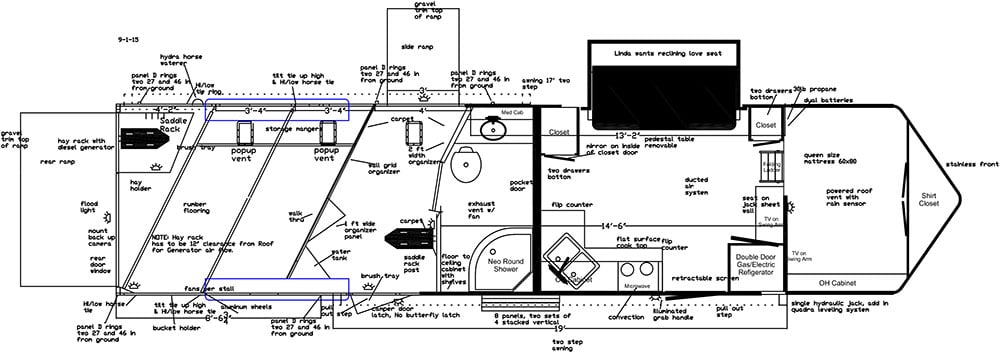A Guide to Horse Trailer Terminology
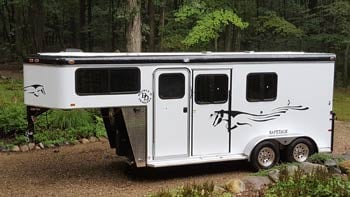
What’s stopping you? Are you overwhelmed by options and features? Having trouble understanding the difference between a gooseneck and a living quarters horse trailer? Not sure what length short wall will work best for you?
We’ve made a list of common horse trailer terms you’re likely to see in ads, on websites or in forums. Don’t let horse trailer terminology take the wind out of your sails.
Basic Horse Trailer Categories
Aluminum Horse Trailer. Some aluminum metal can be safely used as a wall layer in an insulated horse trailer. However, horse trailers made with a single layer of aluminum on the walls or ceiling present a safety hazard. That’s because aluminum conducts heat well and is not strong enough to protect your horse. In particular, road vehicles with all-aluminum construction have done poorly in crash tests.
Bumper Pull. A term used to describe trailers that are pulled via the ball on the bumper of your trailer. Bumper pull trailers tend to be less expensive, but can be more difficult for many drivers to haul.
Gooseneck. Unlike bumper pull trailers, gooseneck horse trailers have an extra storage area that extends over the back of your truck and a hitch that attaches to a special receiver in your bed. Goosenecks can be more expensive, but afford a sleeping area for long distance travels and may be easier to haul than bumper pulls.
Living Quarters. There’s nothing as neat as horse trailers with living quarters, they’re just like tiny apartments on wheels with a place for your horse in back. Living quarters have come a long way and often feature handy storage, convertible living quarters and small, but fully-functioning kitchens and bathrooms.
Reverse Load Horse Trailer. This is a growing trend in the horse trailer industry. Horses are loaded so their head is facing towards the rear of the trailer. Studies show that reverse load horse trailers allow them to balance better and stay calmer while traveling.
Slant Load. Slant load horse trailers make better use of space by loading your animals on a slant instead of straight forward. A 3 or 4 horse slant load trailer will be much shorter front to back than a straight load trailer. Customize your stall sizes to make your slant load horse trailer work for Warmbloods and other large 17+ hand breeds.
Straight Load. When a horse trailer is built with rectangular horse stalls with the horses facing directly forward, they’re referred to as straight load trailers. Straight load trailers have plenty of uses, especially if you have normal to small sized horses. The disadvantage is that they tend to be very long if you want a 4 horse trailer. Plus, the butt and chest bars can present a safety hazard.
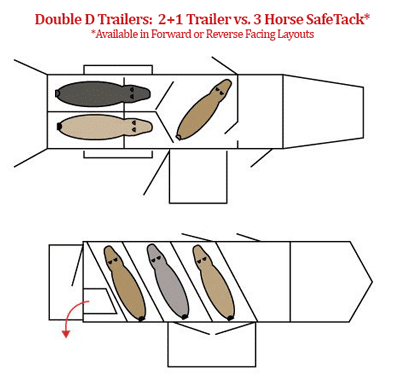
2+1 Horse Trailer. In this 3 horse trailer, two horses are standing in straight load stalls in the rear area of the trailer. Then, a third horse stands in a square box stall towards the front. Many people like to use the box stall while at shows as a prep space or show day stall. However, the SafeTack 3 horse trailer provides the same benefit without the safety hazards in a 2+1.
Towing Terms
Gross Vehicle Weight Rating (GVWR). If you’re wondering just how much weight a trailer can haul, refer to its GVWR. This number is the maximum weight a trailer can handle, including its own weight, equipment and cargo.
Gross Axle Weight Rating (GAWR). Like the GVWR, the GAWR is an expression of how much weight a trailer can handle, but on each of its axles instead of across the whole vehicle.
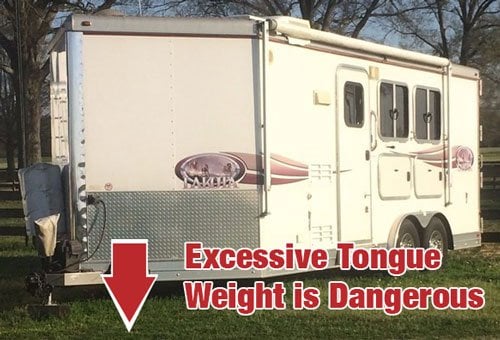
Weight Distribution Hitch. A standard hitch on a horse trailer can lead to disaster if you’re not very careful and very lucky. The weight distribution hitch helps to spread out the weight a little more, resulting in an easier pull and safer ride for your horses.
Horse Trailer Features
Bulk Head Wall. This is the wall that separates the rear horse area from the front dressing room or living quarters.
Chest/Butt Bars. You’ve probably seen bars or chains at the front and back of a horse to keep them in their stall. When panicking, some horses will loop a leg over these bars resulting in injury. Make sure the bars have safety pins so they can be dropped down even with the full weight of the horse on top. Better yet, get a slant load trailer where no butt or chest bars are needed.
Escape Door. Located at the front of the horse compartment, an escape door gives handlers a way to get out of danger quickly.
Head Divider. When you’ve got horses in the trailer, the last thing you need is for them to get spooked and jump into the stall next to them. Head dividers prevent this from happening by creating a head-height partition between horses. Tubular dividers – with bars spaced evenly apart -- are much less stressful on horses than solid dividers. They allow air and light to flow while still providing a safe barrier between horses.
Horse Compartment. This is the part of the trailer where all your horses hang out during trips. Even if you use part of this area for hay or feed storage, it’s considered the horse compartment if it’s not part of the tack room or living quarters.
Horse Stall. Your horses should each have their own section in the trailer where they can comfortably get away from their neighbors. This is your horse stall -- and horse trailers usually have two to four of them.
HI Ties. The outside of a horse trailer is not actually the best place to tie a horse. (I know this sounds crazy!) Instead, a Hattie is a long bar that can swing out from the side of the trailer with a loop to tie your animal. This way, they stand farther from the trailer and can’t injure themselves or damage the trailer.
Jack Sheet Wall. This is a vertical wall on a gooseneck horse trailer where the jack is fastened. The jack is used to raise and lower the trailer to hitch and unhitch from a tow vehicle.
Long Wall. In a slant-load trailer, your living quarters or tack room will be more of a trapezoid than a proper square or rectangle, resulting in one wall being longer than the other. The long wall is the longest of these walls, roughly five feet longer than the short wall.
Portable Corral. These portable corral gates can be secured to the outside of the trailer. When you arrive at your destination, set up the gates to create a corral to safely secure your horses.
Short Wall. On a slant load trailer, the living quarters is often a trapezoid shape rather than a true rectangle. It has a “long wall” and a “short wall”. The short wall is often used to describe a trailer so a buyer knows how big the living quarters area will be.
Stud Gate. Does your horse kick out at other horses? You may want to install a solid stud gate which is a divider that reaches all the way to the floor of the trailer. It prevents kicking between horses.
Safety Features
Galvalite. A well-built trailer will have two layers of insulated material on the walls to prevent noise and excess heat. The inner wall of our trailers is built with a special zinc-coated material called Galvalite.
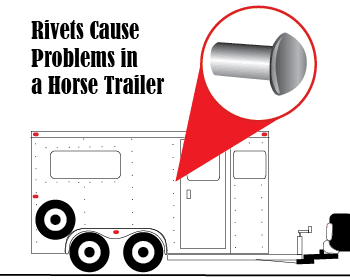
Rivet-Free Trailer. Horse trailers with metal rivets holding the skin to the frame tend to be noisy and rivets provide entry for moisture to break down your trailer. Our rivet-free design looks great and protects the trailer from water damage.
Rumber Flooring. There are many types of horse trailer flooring. We recommend Rumber flooring made from recycled tires. Like pine boards, it prevents heat, noise, and vibration transfer from the road. It’s also very easy to clean and does not require heavy rubber mats.
SafeBump. This type of roof is made from a single molded layer of fiber composite material. It is designed to protect your horse’s head in the case of rearing. Plus, it does not have joints, so it doesn’t leak and keeps the interior of your trailer cool.
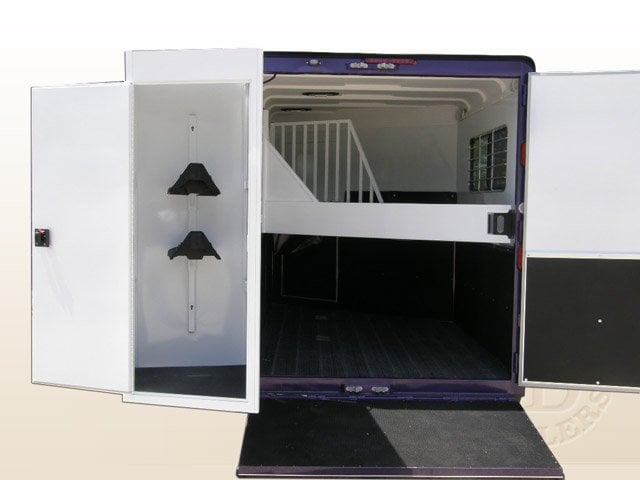
SafeTack. Most conventional slant load trailers have a rear tack compartment that doesn’t move. This creates a very unsafe and narrow loading and unloading doorway. In contrast, a SafeTack trailer has a rear tack compartment that swing out like a second door. It is much safer for loading and horses prefer the wide open feel.
Z-Frame. Rather than using aluminum or pure steel for the trailer’s frame, we use a product called Z-Frame. It’s made of steel impregnated with zinc for extra strength and durability. A Z-Frame Trailer will be as strong as a steel frame trailer without the added weight.
Human Amenities for Your Trailer
Cowboy Shower. Cowboy showers typically consist of a sprayer that’s hooked to your water supply, heated or not. They sound pretty primitive, but after several days at a horse outing, cowboy showers beat washing up in a horse trough!
Dressing Room. Sometimes referred to as the tack room, a dressing room is a small finished area in the front of a horse trailer that can be used to store personal goods, unfold a cot or simply change before a horse event.
Mid-Tack Storage. Need extra space for your equipment? A mid-tack storage area is an extra tack room placed between the horse area and the living quarters or dressing room. It has a separate door and you can walk in to access your tack.
Slide Out. Expand the space in your living quarters with a slide out. The entire dining or seating area can pop out from the side of your trailer to allow you extra floor space to hang out with your friends or family.
Now that your horse trailer vocabulary has been expanded, you’ll be able to more confidently choose your next horse trailer. If you’re ready to start exploring the options, check out our Horse Trailer Buyer’s Guide or contact Brad Heath with questions.

